Stone, minerals and semiprecious of the world stone
Carbonate: Aragonite -->rus
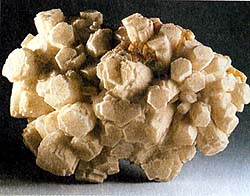 Diagnostic cart.
Diagnostic cart.
On a photo: crystals of aragonite, encrusted white Calcite with by sulphur (Sicily). Down prismatic aragonite with a Pyrite.
Ca СO3
Crystal structure rhombic
Hardness on the Mohs scale 3,5-4
Specific unit weight mass 2,95
Cleavage divided hardness
Fracture, break padman
Colors colourless, polycoloured (multicoloured)
Colors in powder triturate white
Glance (glitter, glare) glassy

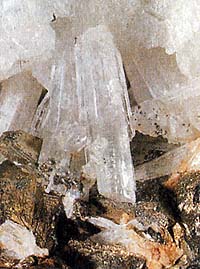 Aragonit is a calcspar, hard variety of Calcite. Forms separate crystals, exceptionally thin and extended. Often they unite in the magnificent aggregates of fascicular or radiant structure. There are also large crystals, paired twin (duplex) for three individuals, a hexagonal prism appears here. Such twins are easily recognized, as in them incoming corners are revealed in relation to the tops of prism, and main - on the plane of their bottom base shading is visible in three different directions, each of which corresponds a separate crystal. Sometimes mineral takes a shape accumulations of shallow marbles (globule), stalactites, fibred the masses and encrustations.
Aragonit is a calcspar, hard variety of Calcite. Forms separate crystals, exceptionally thin and extended. Often they unite in the magnificent aggregates of fascicular or radiant structure. There are also large crystals, paired twin (duplex) for three individuals, a hexagonal prism appears here. Such twins are easily recognized, as in them incoming corners are revealed in relation to the tops of prism, and main - on the plane of their bottom base shading is visible in three different directions, each of which corresponds a separate crystal. Sometimes mineral takes a shape accumulations of shallow marbles (globule), stalactites, fibred the masses and encrustations.
Aragonit is colourless, transparent and possesses glass brilliance. It is enough hard and heavy, differs fragility and well noticeable cleavage on a prism, on the planes of which, however, it is divided hardly. A lot of varieties has aragonite. Among them coral-like aragonite is with white forks, reminding coral. It is named also flos-feri (ferrous flower), as was found out him in an iron-ore deposit in Shtirii. In addition, select pisolite (oolite) aragonite as spherical concretion, and also tarnovcite and Nicholsonite, containing the admixtures of lead and zinc accordingly.
Chemical composition (chemistry, compound) is maintenance (in %): SAO - 56; So2 - 44; the admixtures of strontium, magnesium, iron are marked. Crystal structure - rhombic, rhombo-dipyramid, bipyramid type of symmetry.
Aragonit is a calcspar, hard variety of Calcite. His color varies from white to chlorine and violet. Compounds of lead, strontium and zinc could enter in the complement of aragonite. Term of "aragonite at the beginning of XIX century a saxon geologist entered in everyday life A. Werner. It formed him from the name of locality in Spain - Aragonii, where it was first found out the deposit of aragonite.
Aragonity quite often have a spherical structure. From here the alternative names of this mineral, underlining this his feature: "pea", "hard-roed stone" In geology spherical or ellipsoidal formations, possessing the concentric-stratified or radially-radiant structure, are named by oolite (Greek. ооп is a "egg" of lithos - "stone"). Therefore spherical aragonite name "oolitic stone" or simply "oolite". Aragonity, having a whimsical form of "sprigs" or "stems", name "ferrous flowers". Aragonit can meet as semilucent crystals. This mineral enters in the complement of shells of shellfishes, therefore aragonite is vividly named also "Mother of Pearls".
Varieties: konkhite is basic component part (along with a chitin) of Pearls and mother-of-pearl layer of shells of shellfishes; pea stone - hardpan oolite, pisolite aragonite. Originally hydrothermal and hypergene.
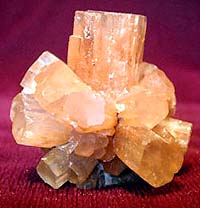 Diagnostic indication.
Diagnostic indication.
Aragonit dissolves in dilute cold acids with the energetic boiling up. It is alike this on Calcite, but the last differs perfect cleavage on a rhombohedron. Some standards of aragonite in ultraviolet rays find out luminescence of different color (dark blue, rose, yellow). At a normal temperature and pressure aragonite is enough unsteady and aspires to transformation to Calcite, thus this phenomenon is accelerated at heating.
Origin provenance genesis.
Less widespread, what Calcite, aragonite be found mainly in the deposits of low temperatures, formed near-by a surface (caves, areas of oxidization of ore deposits, cold sources), and also in some basic sediments and metamorphic rocks.
Deposit minefield mine and use.
Found out aragonite in the great number of places in Italy. In cracks among serpentine rocks it is found in Kon'e and Emarese (Aosta), in Franshe in Val'-malenko (province of Sondrio) and in Monteramasso near Sestri-panente (a province is Genoa). Aragonit is presented needle-shaped individuals in emptinesses among granular limestone, marble "jiropearle" in Passo-della-vorkola (a province Vichenca), in emptinesses of sandstones near-by Agordo (province of Belluno).
As crystalline the masses of fibred or radiant structure of whitish or blue color (the last variety is known under the name mossotite) aragonite be found in Zherfale (province of Grosseto). As crystals this mineral is found in emptinesses among lavas of Vesuvius and Etny. The best copies, including paired twin (duplex) and pseudohexagonal, act from Roma and Sicilian deposits grey.
Aragonit got the name at the place of find are areas Aragon in Spain. rhombic modification of calcspar. Glance (glitter, glare) glassy. Varies from almost transparent to opaque. Colors: grey, rather yellow, white, pink, rose, blue; it is colourless. Fracture, break padman. Fragile. Cleavage noperfect absolute. At influence cold dilute muriatic acid "boils" up intensively, like Calcite, and selects the bubbles of carbon dioxide. Appears in hydrothermal ore deposits, cracks, and also in caves.
As rockforming mineral has a second-rate value. The wandering lime deposits of warm mineral springs are built, for example, them in Karlovy Vary - shprudelstern and pea stone. In time aragonite always passes to more stable modification - Calcite, therefore there are not his ancient deposits in nature.
Aragonit is one of components, composing the shells of shellfishes, Pearls. Crystals (rhombic Crystal structure) meet much rarer, than at Calcite. They have the appearance of prisms with sharp wedge-shaped heads or form radially-radiant joint, junction of needle-shaped crystals, parallell-fibred aggregates, oolite, beautiful branching out forms (ferrous flowers). Chasty twins and branch boxes. Places of distribution: Garc (Germany, Germany), Karintiya (Austria), Karlovy Vary (Czechia), Italy, Spain.
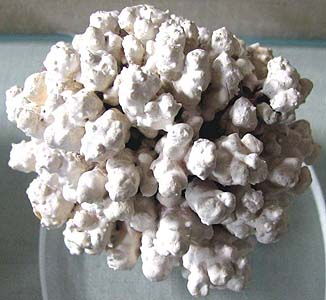
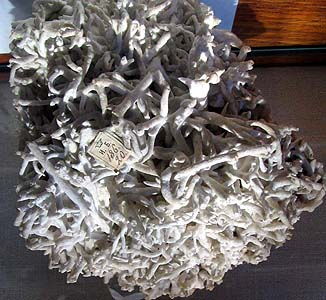
Aragonite. Bata (reefs after a city breakwater), Rio-Muni, Ekv. Guinea. Aragonit. Karintiya, Austria (EU). A photo: © A.A. Evseev.
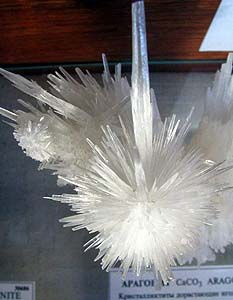
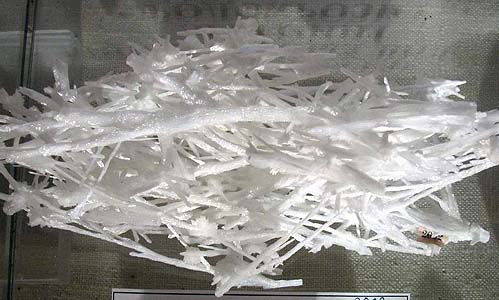
Aragonite. Crystallictite. Khaydarkan, Kirghizia. Aragonit.
Delicate cellular framework from Crystallictite. A cave is "Gipseous",
Khaydarkan, Kirghizia, Asia, CIS. A photo: © A.A. Evseev.
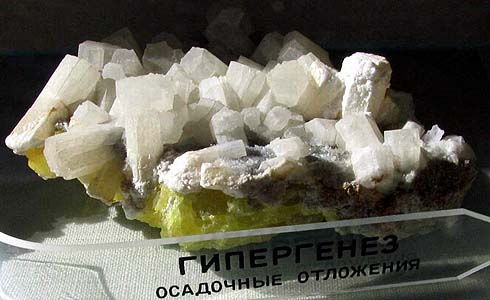
Aragonite. Chianchiana \ Cianciana, Sicily, Italy, EU. A photo: © A.A. Evseev.
